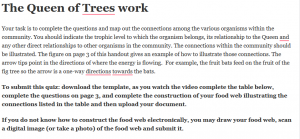The Queen of Trees work

Your task is to complete the questions and map out the connections among the various organisms within the community. You should indicate the trophic level to which the organism belongs, its relationship to the Queen and any other direct relationships to other organisms in the community. The connections within the community should be illustrated. The figure on page 3 of this handout gives an example of how to illustrate those connections. The arrow tips point in the directions of where the energy is flowing. For example, the fruit bats feed on the fruit of the fig tree so the arrow is a one-way directions towards the bats.
To submit this quiz: download the template, as you watch the video complete the table below, complete the questions on page 3, and complete the construction of your food web illustrating the connections listed in the table and then upload your document.
If you do not know how to construct the food web electronically, you may draw your food web, scan a digital image (or take a photo) of the food web and submit it.
Trophic levels: The position that an organisms occupies in a food chain. It shows the flow of energy through an ecosystem. Energy is always lost from one trophic level to the next.
· Producers – autotrophic organisms using solar or chemical energy to produce all the organic nutrients for an ecosystem.
· Consumers – heterotrophic organisms that cannot make their own food. They get energy from the chemical bonds in the nutrients they eat.
· Primary consumers (herbivores) – eat primary producers (plants).
o Conversion efficiency: only 10 to 20 percent of the available energy passes from producers to primary consumers.
· Secondary consumers (carnivores) – eat primary consumers (herbivores).
o Conversion efficiency: only 5 to 10 percent of the available energy passes from primary consumers to secondary consumers.
· Tertiary consumers (carnivores) – eat secondary consumers (carnivores).
o The conversion efficiency for tertiary consumers may be as low as 1%.
· Omnivores – eat both plants and animals.
· Decomposers – break down dead tissues and wastes.
Table 1 – Relationships and trophic levels
Organism
Trophic Level
Connections with the Queen/community
Sycamore Fig Tree
Primary producer
Fig wasp
Grey Horn Bill
Secondary consumer
Uses the Queen as a nesting site, consumes insects that prey on queen
Caterpillars
Giraffes
Fig Cadidid
Pink Mantis
Vinegar Flies
Parasitic Nematodes
Ants
Hilda bug nymphs
Bees
Fig Cicadas
Monkeys
Gecko
Spider
Crocodile
Elephants
Tiger beetles
Butterflies
Seed bugs
Fruit bats
Primary consumers
Seed dispersal for the Queen
Questions
How does the Queen protect herself from predation?
What do the ants provide for the Queen?
What do the ants get in return for their service to the Queen?
What interesting behavior did the Fig cicadas display? What is the ultimate causation of this behavior?
What service do the fig wasps provide for the Queen?
How does the Queen provide payment for the service by the fig wasps?
What happened to the second horn bill chick?
How does the gecko protect itself from being consumed by the snake?
How did the humans gather honey?
The behavior the bees displayed as the humans gathered the honey is an example of proximate or ultimate causation?